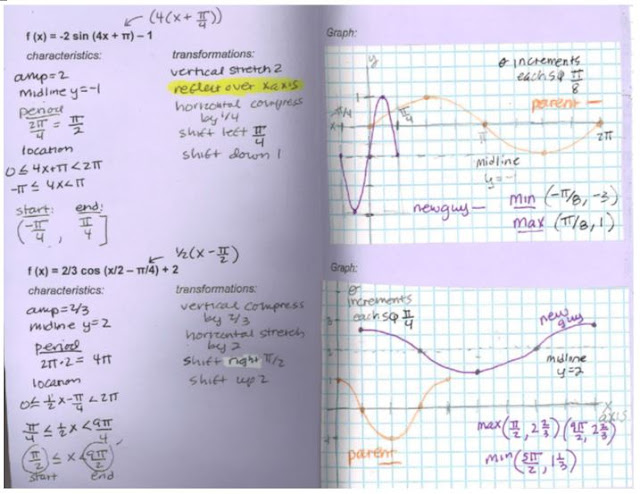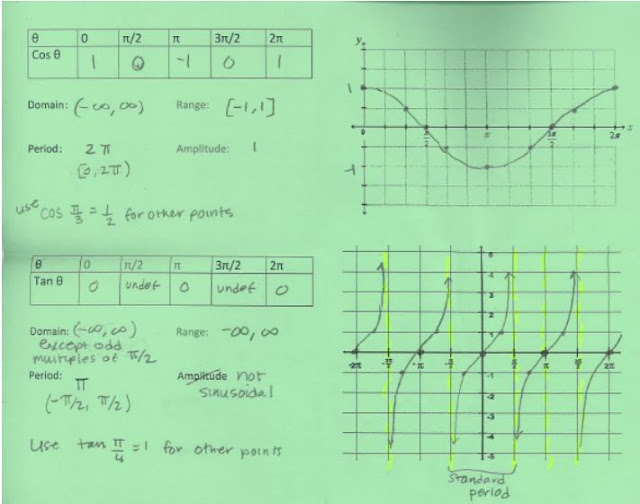My pre-calculus students are now very good at graphing sine and cosine with all sorts of transformations. We've completed our work on inverse functions. So now we are ready to dive into applications of sinusoidal functions.
We start by revisiting the Ferris wheel. This is how I like to introduce sine and cosine graphs this unit (after spending time with the unit circle and rotations it is a great way to see how we get the sinusoidal graph from a circle, see my blog post here for details).
We begin with this scenario:
1 A Ferris wheel has a diameter of 30 m, with
the center 18 m above the ground. It makes one complete rotation every 60
seconds.
I I have students draw a graph for this, showing one complete rotation. Then I pose the question, what would a sine equation for this scenario look like? How can we go about calculating that? What do we need for our equation?
We use the standard form of the sine equation and talk about what we can use for values for a, b, c, & d.
from there students identify the amplitude, the period and the midline. We use the lowest point ( ) to calculate our "c" value. And ta-da we have our sine equation.
then we use this equation and what we know about the scenario to answer questions:
Here is the work used to calculate these:
Our next example looks at situations that take place over a year's time (thus fixing the period length to 365 days). We start with this group example:
Events
that are cyclic (or periodic), such as seasonal variations in temperature, can be
modeled with trigonometric functions.
Regina is the capital of Saskatchewan, a province in Canada. The average
temperature for Regina is hottest at 27o C on July 28, and coolest
at -16oC on January 10.
We jump right in to finding the equation for this situation. Again using the basic sine equation and deciding what we already know (period and using the dates and temperatures we can calculate the amplitude and midline). Again we use the minimum temperature to solve for "c". The result is not as perfect as our Ferris Wheel sine equation as the real life data is not as perfect as a perfectly circular Ferris wheel rotating at a constant speed. But it's very close. (you can see the problem with it by calculating the hottest temperature using the equation, it doesn't give you exactly 27 degrees).
I like to draw the graph for these yearly events after I have the equation. It's easier to do that than just working with two pieces of data. I can get some other points on the graph with my equation.
Then I have students answer a few questions using the equation.
From here I now have students work on a packet of problems related to those two examples. They work together in small groups and do some problems for homework as well. This packet is used over a two day period. You will see those two class examples embedded in the worksheet (I put them there so there is a hard copy record of them, also my scanned answer key has all the details of "how to" for all the problems. This is helpful for absent students).
On the second day (or third depending on scheduling etc( we do a little bit of summarizing with some ISN inserts for our notebooks. I have a two page spread where we model two examples. One in which the given information is the description of a scenario:
The second example uses a set of data. We "hand-calculate" the sine equation but then we compare it to the regression equation from the graphing calculator.
I have students attach the problem only on the left margin with tape (both front & back to keep it secure) so they can show the graph on the reverse side. (we don't tape it in until after they draw the graph). We show both our "hand-calculated" graph and the calculator regression graph. Very similar.
At some point I do discuss the difference between the form of the equation we use to create our equation
Versus the equation the TI graphing calculator uses to create the regression equation:
y = a sin (bx+c)
Two big differences. First the "b" value is not factored out. We always factor out our "b" value to isolate the true "c" value which illustrates the right/left shift in our graph. In the graphing calculator model this shift is obscured by the horizontal stretch/compress action. Also the calculator uses +c and we use -c to indicate the counter-intuitive nature of the right/left shift.
So what can happen (as seen in the work in the above example) the regression equation can be very similar to our equation in the amplitude and period and midline but be quite different in the "c" value. Even if you factor out the value of b. This comes from the fact that the calculator zeroed in on a different "standard period" than we did in our calculations. Basically my understanding is that a sine equation transformations indicate what transformations take place on the parent function of sine with the basic period of 0 to 2pi. It show where the "new standard period" shifts to. Our lines are very close, we just have different "new standard periods". Hope this makes sense!
And finally we wrap things up with a performance task that has students collect data on number of daylight hours at various latitudes. The project introduction reads:
In this project you will develop equations and apply sinusoidal functions that model the number of hours of daylight for locations in the world at different latitudes. To study the relationship between latitude and the number of hours of daylight, data will be collected and analyzed. Using the example of the number of daylight hours, you will then investigate other sinusoidal phenomena.
This will be the second year I am using this project. It is a bit time consuming so I do give them some time in class to get started. Then students need to manage their time well to complete the project. I warn them it's a bit involved so not something they should leave until the night before it's due to work on (as so many seem to do!).
This link will bring you to all my graphing sinusoidal function files including applications.






















































